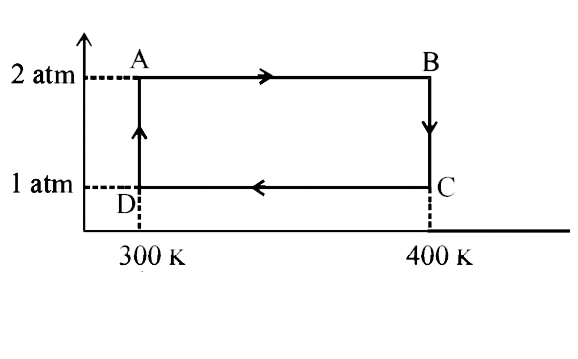Two moles of helium gas undergo a cyclic process as shown in Fig. Assuming the gas to be ideal, calculate the following quantities in this process

(a) The net change in the heat energy
(b) The net work done
(c) The net change in internal energy
As we know in a process, the change in head ererngy of heat shpplied to the gas is equal to the net work done by the gas
Here, AB is isobaric process. Hence, work done during this process form A to B is
WAB=P(V2−V1)=nRT(T2−T1)
or WAB=2×8.314×(400−300)=1662.8J
Work done during isothermal process form B to C is
WBC=nRTC1n(V2/V1)=nRT+(C)1n(P1/P2)
=2×8.314×400×1n(2)=2×8.314×400×0.693
=4601.2J
Work done during isobaric process from C to D
WCD=nR(TD−TC)=2×8.314×(300−400)
=−1662.8J
Work done during isothermal process from D to A
WDA=nRTD1m(PD/PA)
=nRTD1n(2)
=−2×8.314×300x0.693
=−3437.7J
Net down done
=WAB+WBC+WCD+WDA
=1662.8+4610.2n−1662.5=3457.7=1152.5J
Now from the first law of thermodynamics
ΔQ=ΔU+ΔW
Here, ΔQ=ΔW=1152.5J
So the heat given to the system is 1152.5 J
As the gas returns to its original state, there is no change in internal energy.
Topper's Solved these Questions
- KINETIC THEORY OF GASES AND FIRST LAW OF THERMODYNAMICSBook:CENGAGE PHYSICSChapter:KINETIC THEORY OF GASES AND FIRST LAW OF THERMODYNAMICSExercise:Exercise 2.1
Explore 20 Videos
- KINETIC THEORY OF GASES AND FIRST LAW OF THERMODYNAMICSBook:CENGAGE PHYSICSChapter:KINETIC THEORY OF GASES AND FIRST LAW OF THERMODYNAMICSExercise:Exercise 2.2
Explore 28 Videos
- KINETIC THEORY OF GASES AND FIRST LAW OF THERMODYNAMICSBook:CENGAGE PHYSICSChapter:KINETIC THEORY OF GASES AND FIRST LAW OF THERMODYNAMICSExercise:Interger
Explore 11 Videos
- KINETIC THEORY OF GASESBook:CENGAGE PHYSICSChapter:KINETIC THEORY OF GASESExercise:Compression
Explore 2 Videos
- LINEAR AND ANGULAR SIMPLE HARMONIC MOTIONBook:CENGAGE PHYSICSChapter:LINEAR AND ANGULAR SIMPLE HARMONIC MOTIONExercise:Multiple Correct Answer Type
Explore 9 Videos
Similar Questions
One mole of Helium gas undergoes a reversible cyclic process ABCDA as shown in the figure.Assuming gas to be ideal, answer the following questions :

What is the net work involved in the process A to C :
View SolutionOne mole of Helium gas undergoes a reversible cyclic process ABCDA as shown in the figure.Assuming gas to be ideal, answer the following questions :

What is the value of ΔH for the overall cyclic process:
View Solution
Knowledge Check
Two moles of helium gas undergo a cyclic process as shown in figure. Assuming the gas to be ideal. The net work done by the gas is
 A200 Rln2B100 Rln2C300 Rln2D400 Rln2
A200 Rln2B100 Rln2C300 Rln2D400 Rln2Two moles of helium gas undergo a cyclic process as shown in figure. Assuming gas to be ideal, the net heat exchange in the process will be
 A1000 JB1152 JC1200 JD1500 J
A1000 JB1152 JC1200 JD1500 JTwo moles of Helium gas undergo a reversible cyclic process as shown in figure. Assuming gas to be ideal, what is the net work involved in the cyclic process ?
 A−100Rln4B+100Rln4C+200Rln4D−200Rln4
A−100Rln4B+100Rln4C+200Rln4D−200Rln4
One mole of Helium gas undergoes a reversible cyclic process ABCDA as shown in the figure.Assuming gas to be ideal, answer the following questions :

What is the value of 'q' for the overall cyclic process:
View SolutionTwo moles of an ideal monoatomic gas undergoes a cyclic process ABCA as shown in V-T diagram below:

Heat supplied to the gas during the process AB is :
View SolutionTwo moles of helium gas are taken over the cycle ABCDA , as shown in the P-Tdigram

Assuming the gas to be ideal the work done on the gas in taking if from A to B is -
View SolutionIn a cyclic process, the internal energy of the gas
View SolutionIn a cyclic process, the internal energy of the gas
View Solution

